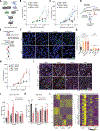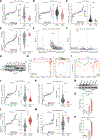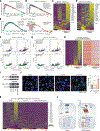Mutant IDH1 inhibition induces dsDNA sensing to activate tumor immunity
- PMID: 38991060
- PMCID: PMC11602233
- DOI: 10.1126/science.adl6173
Mutant IDH1 inhibition induces dsDNA sensing to activate tumor immunity
Abstract
Isocitrate dehydrogenase 1 (IDH1) is the most commonly mutated metabolic gene across human cancers. Mutant IDH1 (mIDH1) generates the oncometabolite (R)-2-hydroxyglutarate, disrupting enzymes involved in epigenetics and other processes. A hallmark of IDH1-mutant solid tumors is T cell exclusion, whereas mIDH1 inhibition in preclinical models restores antitumor immunity. Here, we define a cell-autonomous mechanism of mIDH1-driven immune evasion. IDH1-mutant solid tumors show selective hypermethylation and silencing of the cytoplasmic double-stranded DNA (dsDNA) sensor CGAS, compromising innate immune signaling. mIDH1 inhibition restores DNA demethylation, derepressing CGAS and transposable element (TE) subclasses. dsDNA produced by TE-reverse transcriptase (TE-RT) activates cGAS, triggering viral mimicry and stimulating antitumor immunity. In summary, we demonstrate that mIDH1 epigenetically suppresses innate immunity and link endogenous RT activity to the mechanism of action of a US Food and Drug Administration-approved oncology drug.
Conflict of interest statement
Figures






Comment in
-
Unmasking immune suppression.Science. 2024 Jul 12;385(6705):140-142. doi: 10.1126/science.adq5196. Epub 2024 Jul 11. Science. 2024. PMID: 38991086
References
-
- Pirozzi CJ, Yan H, The implications of IDH mutations for cancer development and therapy. Nat Rev Clin Oncol. 18, 645–661 (2021). - PubMed
-
- Dang L, White DW, Gross S, Bennett BD, Bittinger MA, Driggers EM, Fantin VR, Jang HG, Jin S, Keenan MC, Marks KM, Prins RM, Ward PS, Yen KE, Liau LM, Rabinowitz JD, Cantley LC, Thompson CB, Heiden MGV, Su SM, Cancer-associated IDH1 mutations produce 2-hydroxyglutarate. Nature. 462, 739–744 (2009). - PMC - PubMed
-
- Xu W, Yang H, Liu Y, Yang Y, Wang P, Kim S-H, Ito S, Yang C, Wang P, Xiao M-T, Liu L, Jiang W, Liu J, Zhang J, Wang B, Frye S, Zhang Y, Xu Y, Lei Q, Guan K-L, Zhao S, Xiong Y, Oncometabolite 2-Hydroxyglutarate Is a Competitive Inhibitor of α-Ketoglutarate-Dependent Dioxygenases. Cancer Cell. 19, 17–30 (2011). - PMC - PubMed
-
- Losman J-A, Koivunen P, Kaelin WG, 2-Oxoglutarate-dependent dioxygenases in cancer. Nat Rev Cancer. 20, 710–726 (2020). - PubMed
Publication types
MeSH terms
Substances
Grants and funding
- U19 CA264504/CA/NCI NIH HHS/United States
- R01 CA235412/CA/NCI NIH HHS/United States
- K22 CA237752/CA/NCI NIH HHS/United States
- F30 CA271634/CA/NCI NIH HHS/United States
- P01 CA117969/CA/NCI NIH HHS/United States
- K99 CA277576/CA/NCI NIH HHS/United States
- R01 CA219670/CA/NCI NIH HHS/United States
- K22 CA288784/CA/NCI NIH HHS/United States
- K99 CA245194/CA/NCI NIH HHS/United States
- R01 CA258586/CA/NCI NIH HHS/United States
- R01 CA215498/CA/NCI NIH HHS/United States
- P50 CA127003/CA/NCI NIH HHS/United States
- R01 CA280085/CA/NCI NIH HHS/United States
- P50 CA165962/CA/NCI NIH HHS/United States
LinkOut - more resources
Full Text Sources
Medical
Molecular Biology Databases
Research Materials
Miscellaneous

